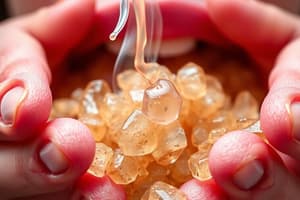Podcast
Questions and Answers
What is the function of the lacrimal glands?
What is the function of the lacrimal glands?
- To cover the surface of the eye from the inner surface of each lid
- To anchor the soft tissues that support the functions of the eye
- To produce tears that wash away particles from the surface of the eye (correct)
- To protect the eye from abrasions by blocking particles
Where are the eyes located?
Where are the eyes located?
- Behind the ears
- Embedded in the nasal cavity
- On the surface of the skull
- Within the skull orbits (correct)
What is the function of the conjunctiva?
What is the function of the conjunctiva?
- To protect the eye from abrasions by blocking particles
- To anchor the soft tissues that support the functions of the eye
- To cover the surface of the eye from the inner surface of each lid (correct)
- To produce tears that wash away particles from the surface of the eye
What is the purpose of the eyelids and lashes?
What is the purpose of the eyelids and lashes?
What is the function of the skull orbits?
What is the function of the skull orbits?
Flashcards
Lacrimal glands function?
Lacrimal glands function?
Produce tears to wash away particles from the eye's surface.
Where are the eyes located?
Where are the eyes located?
Within the skull orbits.
What does the conjunctiva do?
What does the conjunctiva do?
Covers the eye surface from the inner lid.
Eyelids and lashes purpose?
Eyelids and lashes purpose?
Signup and view all the flashcards
Function of skull orbits?
Function of skull orbits?
Signup and view all the flashcards
Study Notes
Eyes and Their Components
- The lacrimal glands produce tears that moisten and protect the eyes, as well as help to remove foreign particles.
- The eyes are located in the skull orbits, bony cavities that provide protection and support.
Eye Structures and Their Functions
- The conjunctiva is a thin membrane that covers the white part of the eye and the inside of the eyelids, helping to keep the eye moist and clean.
- The eyelids and lashes work together to protect the eye from debris, dust, and other foreign particles, and also help to distribute tears evenly over the eye's surface.
- The skull orbits provide a protective socket for the eyes, allowing them to move freely while protecting them from injury.
Studying That Suits You
Use AI to generate personalized quizzes and flashcards to suit your learning preferences.




